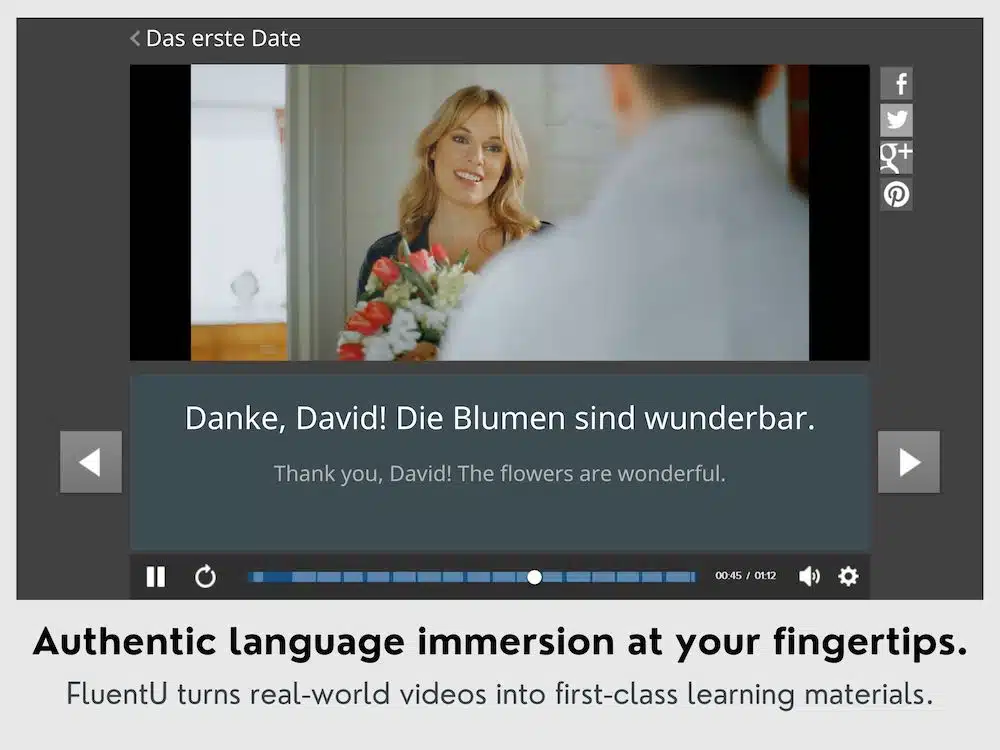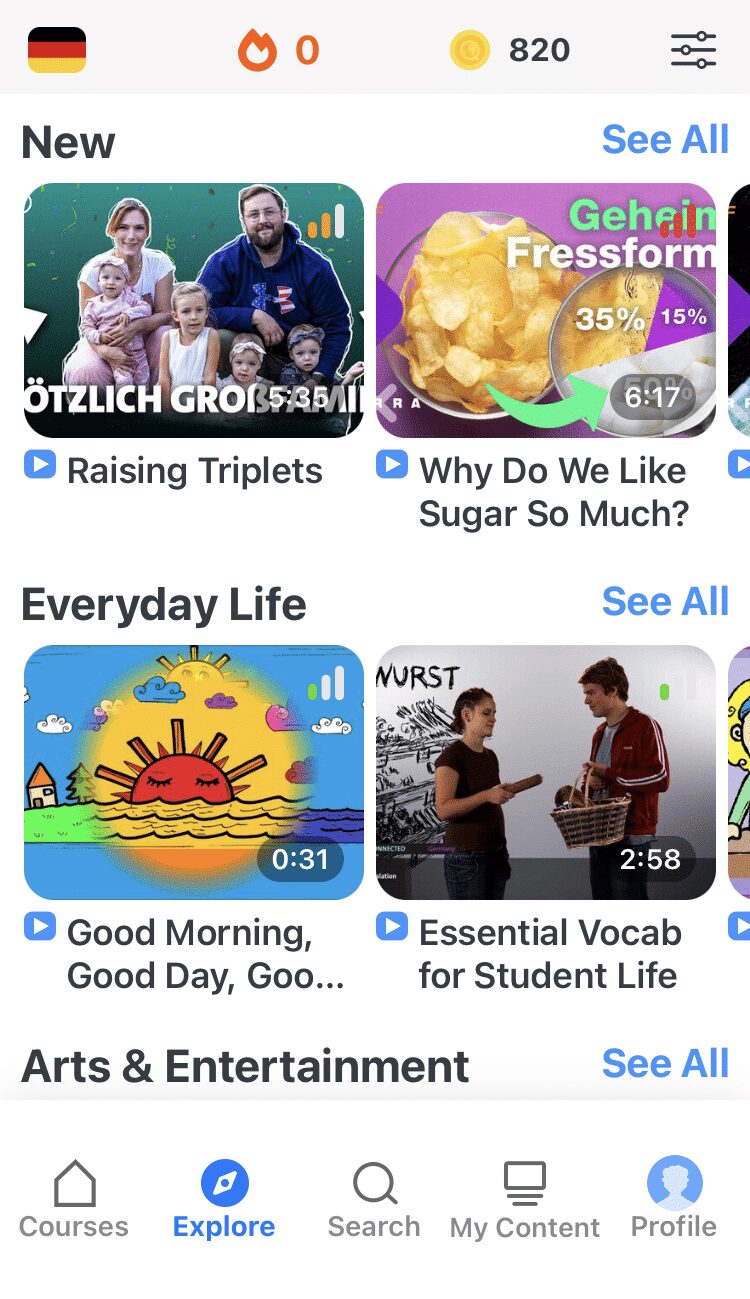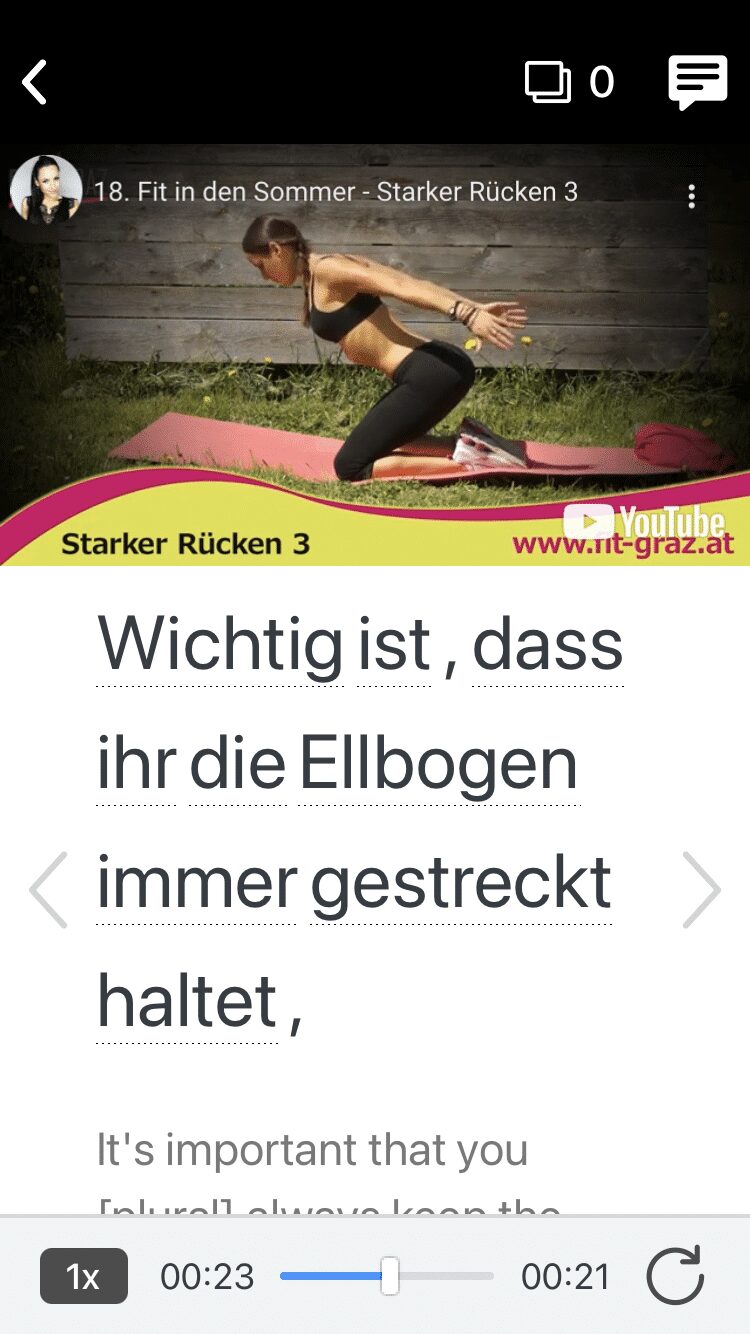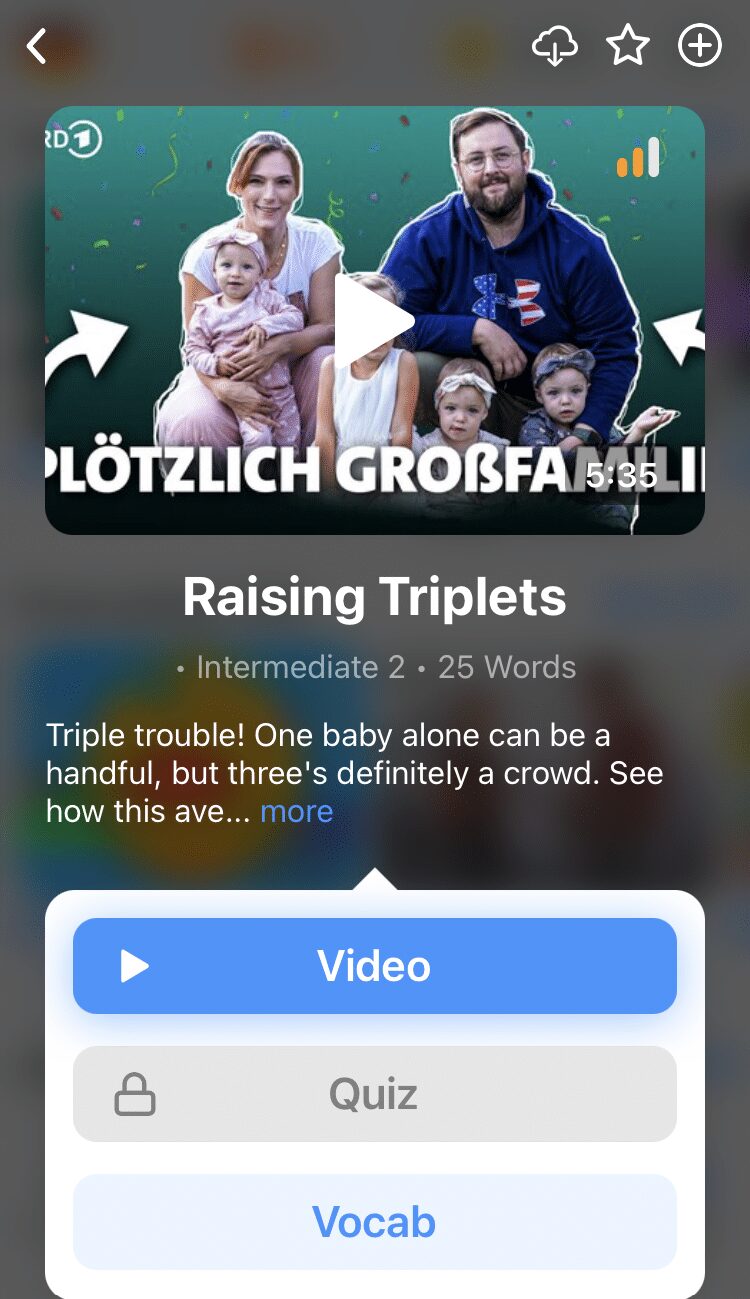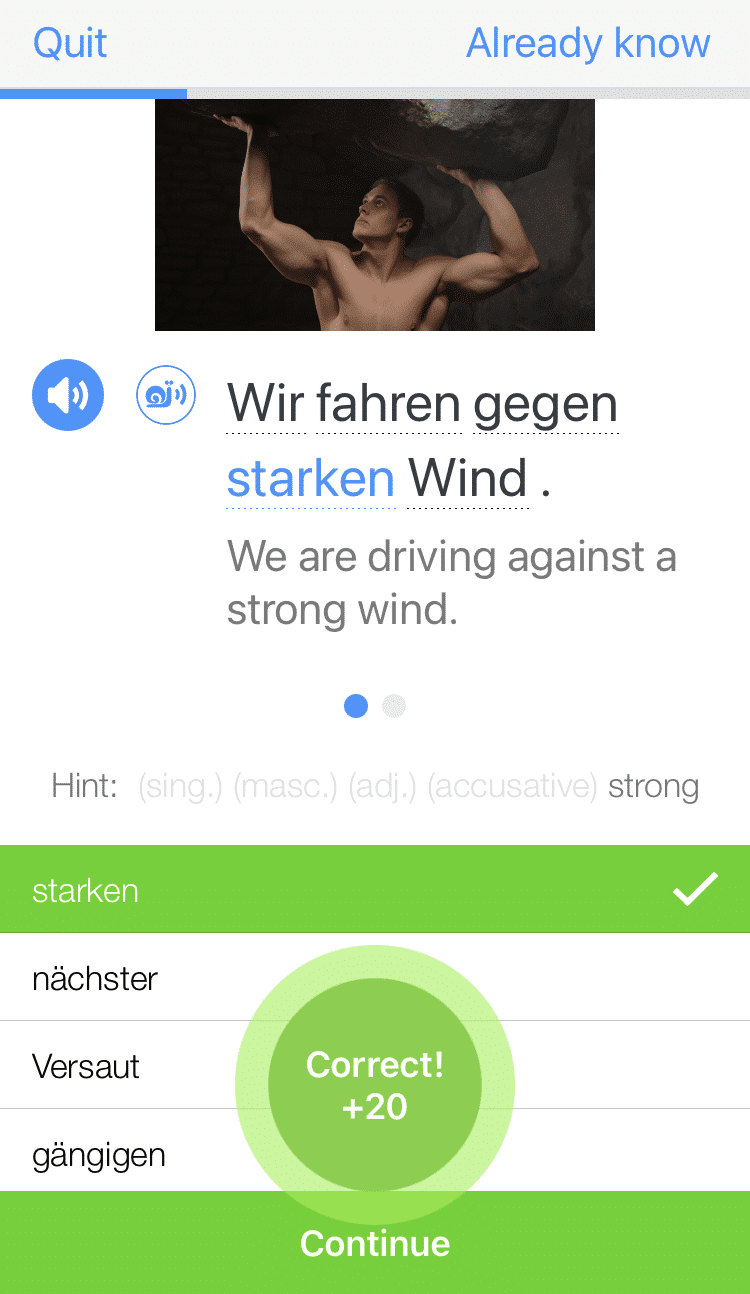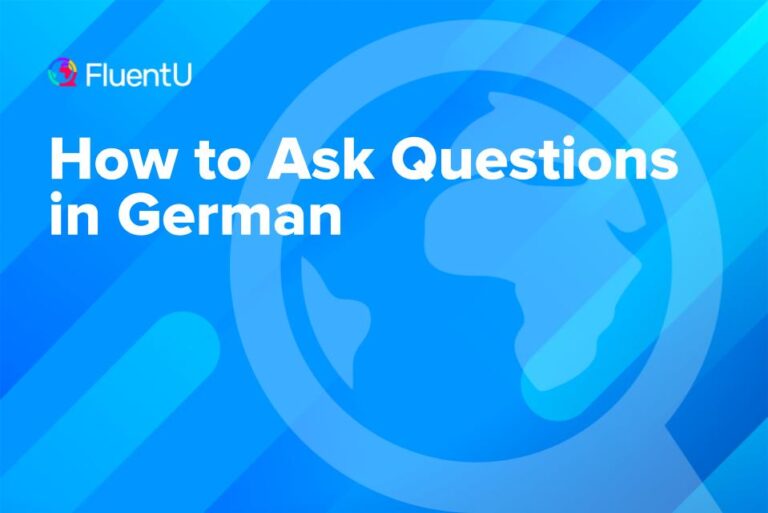Contents
- 1. Get in the right mindset
- 2. Learn the German alphabet and pronunciation
- 3. Learn basic German vocabulary
- 4. Learn basic German grammar
- 5. Find reading material for beginners
- 6. Practice regularly and often
- 7. Move on to advanced texts when you’re ready
- 8. Consult various resources for German reading material
- And One More Thing...
Learn How to Read German: 8 Strategies for Beginners

Being good at reading in German is a crucial skill to have. It enables you to read highway (excuse me, autobahn) signs if you’re visiting Germany, follow along with subtitles on German movies and even read the original versions of literary classics by German authors.
Let’s get started and discover eight great strategies for learning how to read German.
Download: This blog post is available as a convenient and portable PDF that you can take anywhere. Click here to get a copy. (Download)
1. Get in the right mindset
Despite the similarities between the languages, a surprising amount of native English speakers approaches learning German with fear in their hearts. Nowhere is this more apparent than when it comes to reading.
Mysteriously shifting word endings, unfamiliar sentence structure and crazily long words can all present significant stumbling blocks for the beginner.
But learning to read in German is easier than you might think! Here are a few reasons why:
- Reading is a forgiving language skill. You’re free to correct your mistakes, there’s no social embarrassment to contend with and you can set your own pace.
- Children learn how to read every day. Children are not all natural language savants, yet German kids pick up the language perfectly, like ducks to water. You will too. It just takes time, particularly if this is your first foreign language.
- Learning to read is a gradual process. After all, Rome wasn’t built in a day. You don’t need to think of daunting undertakings like “reading a book in German.” Start with smaller pieces, like “read one page” or “read one paragraph.”
- Staying positive helps. Anxiety in the face of a challenge is natural and healthy, but don’t let it morph into fear and stop you from even beginning. Even if you want to learn to read German as an adult, that’s totally doable! As with anything, believing you can is the first step to doing.
2. Learn the German alphabet and pronunciation
German shares the same basic 26-letter alphabet as English.
Take a listen by clicking on each letter in the chart to hear its name in German. In the second column, the bolded letters in the English words give you an idea of the sound the letter makes in German words.
| German Letter | Example Sound |
|---|---|
| a | cup |
| b | boat |
| c | sauerkraut / beats |
| d | door |
| e | yeah |
| f | fish |
| g | gun |
| h | hat (but less aspirated) |
| i | jeep |
| j | yellow |
| k | sauerkraut |
| l | love |
| m | man |
| n | nut |
| o | know |
| p | piece |
| q | cool |
| r | rrr (a guttural trill) |
| s | zebra / singer |
| t | tomorrow |
| u | wool |
| v | father |
| w | vowel |
| x | maximum |
| y | yeah / oops |
| z | bits |
German has four extra letters, as well:
| German Letter | Example Sound |
|---|---|
| ä | bare |
| ö | girl |
| ü | moon ("oo" sound with lips pursed) |
| ß | kiss |
Additionally, there are diphthongs, which are two vowels that form one sound together. Clicking on the diphthongs will let you hear their pronunciation:
| German Diphthong | Example Sound |
|---|---|
| ei | eye |
| ai | eye |
| au | cow |
| eu | boy |
| äu | boy |
| ie | bee or lenient |
And finally, there are digraphs, which are two or more letters (not limited to simply vowels or consonants) that are pronounced as one:
| German Digraph | Example Sound |
|---|---|
| aa | long a |
| ah | ah |
| äh | long ä |
| ch | ugh (after a, o, u) huge (after e, i) |
| sch | sheep |
| ph | philosophy |
| ee | long e |
| eh | ay |
| th | t |
| ck | k |
| sp | shp |
| st | st / sht |
| tsch | batch |
| pf | epiphany without the i |
| ps | tips |
For in-depth coverage of German pronunciation, check out this post.
Learning these sounds thoroughly has two purposes. Firstly, you’re mastering core skills you’ll need for speaking and comprehension. Secondly, you’re training the internal voice you use when reading.
By knowing the German alphabet and common combinations, the words on the page will become real sounds you know how to make rather than just intimidating jumbles of letters. You’ll find yourself starting to actually think in German as you read.
Here are a few pronunciation rules to keep in mind:
- A vowel followed by h is a long vowel and the h itself isn’t pronounced. Some examples: Bahn , Lohn , Lehm , Ihm
- All vowels can be pronounced as long or short sounds.
- If a German word ends with b, d, or g these letters are pronounced p, t, and k respectively.
3. Learn basic German vocabulary
Now that we’ve established how to figure out the pronunciation of German words, it’s time we put our new knowledge into practice by acquiring some basic German vocabulary!
The best results are achieved if you use a German word frequency list and start with the first couple hundred words on it. This will ensure you learn the most helpful words early on in your studies.
You could also use a virtual immersion program.
FluentU takes authentic videos—like music videos, movie trailers, news and inspiring talks—and turns them into personalized language learning lessons.
You can try FluentU for free for 2 weeks. Check out the website or download the iOS app or Android app.
P.S. Click here to take advantage of our current sale! (Expires at the end of this month.)
Even if you learn just five words a day, it’ll only take you 150 days—around 5 months—to master 750 German words!
Of course, learning a word for the first time is one thing, but making it stick is another. Try using a flashcard system to maximize your learning efficiency.
And if you want to have some fun while memorizing your first vocabulary words, you can check out these German words with surprising meanings.
It helps to stick to topics you’re genuinely interested in, too. Once your core vocabulary is in place, it’ll be easier to branch out even more at your leisure.
4. Learn basic German grammar
After learning some basic vocabulary, you’ll want to learn how the words fit together.
However, this doesn’t mean you have to learn a German grammar book from front to end! You just need a base from which to understand the relationships of words within sentences.
The following topics are the minimum requirements for understanding basic German grammar.
Word order
German word order in many cases differs wildly from the structure you’re used to as an English speaker.
Basic German sentences can and do use Subject + Verb + Object word order (like English) as in:
Ich werfe den Ball. (I throw the ball.)
However, there are many instances in German where this isn’t true. Often you’ll find that the verb moves around the sentence quite freely, especially when subordinating conjunctions or relative clauses are involved.
There is simply too much to write about German word order in just a few paragraphs, so check out this post to dive into German sentence structure and proper word order.
Noun genders
The fact that each German noun has its own gender has been the scourge of German students since the beginning of time. Every noun in this language is either masculine, feminine or gender neutral.
This is important because the genders determine the definite and indefinite articles used with each word in a sentence. That in turn becomes important when learning about cases (see below).
Therefore, you should get used to learning the gender and definite articles alongside all nouns on your vocabulary list.
It doesn’t matter if the gender of words makes sense to you or not (hint: they often won’t). Accept it as part of the learning process and it will make your life much easier in the long run!
Again, there’s much that can be said about this aspect of German grammar, so check out more in-depth information in this post.
Plural nouns
Another important thing to learn is how to pluralize nouns. The good news is that all plural German nouns take the same definite article in the nominative case, which is die.
The bad news is that making several things out of one is not as simple as it is in English, where “the house” simply becomes “the houses.” The only surefire way to know the exact plural form of a noun in German is to look it up in a dictionary (see resources below).
There are, however, some rules and regularities in German noun pluralization which should get you started.
For masculine nouns, those that end in -en, -el, and –er often do not change at all in the plural. The only indication of whether they are singular or plural is the definite article:
der Lehrer → die Lehrer
(the teacher → the teachers)
Other masculine nouns often add an umlaut to the noun’s vowel when pluralized, put an -e at the end of the word or both:
der Garten → die Gärten
(the garden → the gardens)
der Weg → die Wege
(the path → the paths)
For feminine nouns, in the majority of cases, the plural form will end in -(e)n:
die Blume → die Blumen
(the flower → the flowers)
If the feminine noun ends in -in, its plural will get -nen added to it:
die Fahrerin → die Fahrerinnen
(the driver [female] → the drivers [female])
And for neuter nouns, those ending in -lein and -chen do not change in the plural. Here, again, it’s important to pay attention to the article to know how many things are being referenced:
das Mädchen → die Mädchen
(the girl → the girls)
Noun cases
German cases are probably among the most frustrating topics when learning the language. At the very beginning, it’s only important to know that the case changes the function of a noun within a sentence.
Depending on which case a word is in, the word itself will change and the parts of the sentence that are dependent on it (such as articles and adjectives) will do the same.
There are four cases, and each fulfills a different function: the nominative case indicates the subject, the genitive case can show possession, the dative case can accompany certain prepositions and the accusative case shows the direct object.
For example:
- das Buch is a nominative subject, as in “The book is interesting.”
- des Buches shows possession in the genitive, as in “I forgot the title of the book.”
- dem Buch is the dative case that follows von (from), as in “I copy a page from the book.”
- das Buch is the accusative direct object, as in “I give the book to my friend.”
For a basic understanding, you should at least learn the cases for all definite articles, indefinite articles and personal pronouns. That way you’ll be able to make out basic relationships within sentences without needing to know how to decline all nouns.
5. Find reading material for beginners
Now that you have both a foundation of German words you can understand and identify as well as a rough idea about how they belong together in a sentence, it’s time to put your knowledge into practice with some easy reading material!
It doesn’t have to be sophisticated (honestly, stay away from reading the newspaper for now), but it should just be something filled with easily-understandable content, preferably on a topic that actually interests you.
Ideas for your first German reading materials:
- Magazines
- Comic books
- Children’s books
- Tabloid papers
- Young adult fiction novels
- German song lyrics
- Fairy tales
My personal preference is to get manga books (Japanese comics) in two languages and read them in parallel. The translation is usually pretty faithful, it’s not too much text in the beginning and it’s very entertaining.
6. Practice regularly and often
Once you’ve gathered your practice material, start reading!
You can choose your reading style for each session. The best choices are:
- Casual reading, or simply reading for the main idea. Here, you don’t want to get hung up on individual words or tricky sentences. The aim is to improve general comprehension rather than progress in a specific area.
- Structured reading, which involves reading closely and taking notes. Go over each sentence in detail, referring to grammar resources and dictionaries, and entering specific items into your flashcard system.
Casual reading will give you a sense of understanding—and therefore of success—without the feeling of drudgery. Structured reading will help you really advance your skills.
A good tip is to have a notepad nearby to write down things you don’t understand, especially if you have a German language partner so you can ask questions later.
You’ll also benefit from keeping a regularly updated list of books you’ve read and intend to read. You can make it a habit to establish scheduled reviews throughout the year to keep track of your progress and current level.
The key to long-term success with reading in German is to make reading a daily activity.
Read a little bit every day. One paragraph can be enough in the beginning. It’s always better to start with a low goal and surpass it than to start with high aspirations and let yourself down.
Consistent practice is more important than perfect performance each time. And as your reading speed naturally increases, it’ll be easier to read more text in the same amount of time.
There is a number of great habit tracker apps out there to help you out with this, but all you really need is a pencil and paper to get started. Keep it up and you’ll soon astonish yourself with your progress!
7. Move on to advanced texts when you’re ready
Once you feel ready, you can start digging into more difficult material.
Again, it’s important to pace yourself and find material at your level. If you feel yourself becoming increasingly frustrated, it’s okay to take it down a notch and choose something easier. Learning to read in German should be exciting, not a chore!
Ideas for next-level material include:
- German blogs and web content
- Novels
- Newspapers
- Short stories
- German classics
- Topic-specific magazines (fitness, gardening, home improvement, etc.)
Once you’ve gotten to the point where you can read and understand most of this kind of material, it’s only a matter of keeping at it. Soon, you’ll be reading German like a native!
8. Consult various resources for German reading material
Below is a list of useful links for your endeavor to learn to read German:
Online reading material
- Deutsche Welle features a lot of articles and other materials for different language levels. This is recommended for those interested in current news and who want to learn more about German culture.
- Der Spiegel is a German news magazine published weekly in Hamburg. You can find current events, opinion pieces and even cartoons available in German via the site.
- Jolie and Elle are two examples of German lifestyle magazines which are available online, geared mostly toward women. Lots of articles are out there, covering many different contemporary German topics as well as fashion and culture.
Bookstores
- Bücher.de is one of Germany’s biggest online bookstores. It can cover all your reading needs, especially if you reside in Germany. However, the service also ships to most European countries. E-books are available as well.
- Amazon features almost 2.5 million books available in German on all kinds of topics and at many difficulty levels. Many of them can also be purchased as e-books so you can start practicing within minutes.
Online dictionaries
- dict.cc is a comprehensive online dictionary for several languages. German is, of course, among them. Quickly look up the meaning of any word you don’t understand on this site.
- Duden used to be THE German-German dictionary back when we still used books to look up words. It gives a lot more than just a word’s meaning (in German)—you can easily look up the gender, pronunciation and plural form of any word as well.
- You can also check out this post for some additional German dictionary apps that you can download right on your smartphone.
That wraps up our no-sweat guide on how to learn to read German!
With these tips, you’ll be well on your way to understanding this great written language and opening yourself up to a lifetime of reading pleasure.
Download: This blog post is available as a convenient and portable PDF that you can take anywhere. Click here to get a copy. (Download)
And One More Thing...
Want to know the key to learning German effectively?
It's using the right content and tools, like FluentU has to offer! Browse hundreds of videos, take endless quizzes and master the German language faster than you've ever imagine!
Watching a fun video, but having trouble understanding it? FluentU brings native videos within reach with interactive subtitles.
You can tap on any word to look it up instantly. Every definition has examples that have been written to help you understand how the word is used. If you see an interesting word you don't know, you can add it to a vocabulary list.
And FluentU isn't just for watching videos. It's a complete platform for learning. It's designed to effectively teach you all the vocabulary from any video. Swipe left or right to see more examples of the word you're on.
The best part is that FluentU keeps track of the vocabulary that you're learning, and gives you extra practice with difficult words. It'll even remind you when it’s time to review what you’ve learned.
Start using the FluentU website on your computer or tablet or, better yet, download the FluentU app from the iTunes or Google Play store. Click here to take advantage of our current sale! (Expires at the end of this month.)

